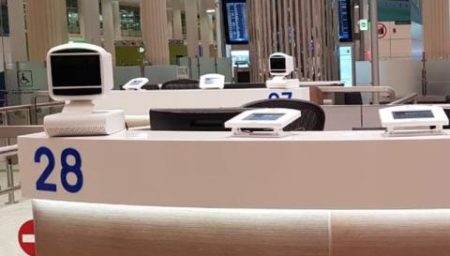Maximizing border guards’ operational efficiency

Land and sea borders are set to be one of the biggest challenges for the implementation of the EU-Entry/Exit System (EU-EES). Nelly Strady, Entry/Exit Product Manager at IDEMIA, tells us more about the specifications of these borders and the tailor-made solutions that are needed.
Land borders are frequented with various modes of transport. Pedestrians, cars, trucks, motorcycles, buses and trains represent operational challenges on how the EU-EES regulation will be applied in these environments. Transportation such as buses, coaches and trains carry many passengers and may even represent more than half the vehicles crossing the border.
Several passengers can travel in the same car, bus or train. As they cross the border, some can stay inside while others may enter or exit the vehicle. A parking lot can be set up or vehicles can queue, while train stations can be redesigned to incorporate a border crossing point. Depending on the location, border guards will stay in a booth or will move from one vehicle to another. Some may even get onto the bus/train or request that all passengers exit the vehicle.
All these specificities highlight the differences in all available infrastructure, and the different processes that will have to be applied, emphasizing how complex the challenge is.
There are as many configurations as there are sea border crossing points. Individuals can enter or exit a country in a variety of vessels. From large cruise ships and ferries to smaller vessels and cargo ships. Again, the possibilities are vast, and the challenges are different. Large cruise ships can have a capacity of 6,000 passengers, plus personnel. The sheer time it would take a border guard to process each individual is extremely consequential. Not forgetting that passengers have a narrow window to disembark and enjoy a few hours at the destination. Small vessels do not always have a predefined route and must be managed at the last minute.
There is a variety of traveler types that must be processed at land and sea borders. Some travelers are visa holders whereas others are exempt. Some are entering the Schengen Area for the first time and some are on a subsequent entry. Some are frequent border crossers, such as heavy goods vehicle drivers, commuters, etc. There are also seasonal travelers, with a high volume expected at selected border control points during the vacation periods – requiring border guards to adapt their capacity to deal with this peak. This greater variety of traveler profiles at land and sea borders, compared to air borders, makes the tasks of border guards even more complex.
Indeed, it is almost impossible to use a single system or method that will satisfy the requirements for all borders for the reasons of cost, space and maintenance. It is clear that system providers cannot offer a one-size-fits-all solution that will encompass every border crossing point. Flexibility and adaptation are key to supporting the various use cases in each environment. All border crossing points need solutions that are tailored to their requirements and constraints. Member States will have to deploy a variety of verification equipment to adapt to the different configurations of their border crossing points.
The border crossing points can have fixed, mobile or handheld equipment. These can be operated by a border guard, used in a self-service mode, or be part of an automated system. There is an array of options that Member States can leverage to best fit their needs. As an example, a land border crossing point that has a high volume of travelers and also has sufficient space could deploy static counters, self-service kiosks and bi-directional eGates inside a hall/terminal, similar to the equipment used at airports. At another land border crossing point, border guards could use mobile equipment to check all passengers as they board a bus or as they queue in their cars. A small seaport could be equipped with similar mobile equipment that would allow border guards to perform the checks when needed, knowing that the flow of travelers is usually not high.

Latest News
Related Content